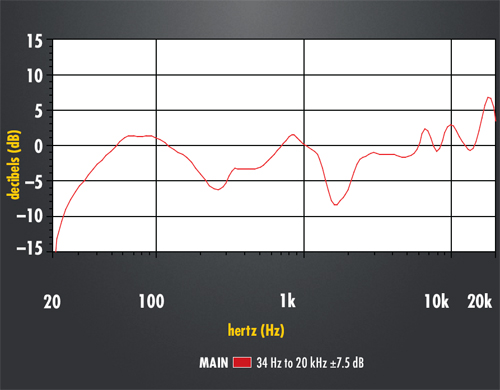ZVOX Incredibase 575 Soundbar Page 3

TEST BENCH
Frequency response (at 2 meters)
34 Hz to 20 kHz ±7.5 dB
Bass limits (lowest frequency and maximum SPL with limit of 10% distortion at 2 meters in a large room)
40 Hz at 82.7 dB
97 dB average SPL from 25 Hz to 63 Hz
103 dB maximum SPL at 63 Hz
Bandwidth uniformity 94%
Maximum full-band output
approx. 97 dB at 2 meters
The frequency-response graph is weighted to reflect how sound arrives at a listener's ears with normal speaker placement. Measurements were made with the mic positioned in front of the center driver at 2 meters to include full effects of cabinet diffraction and front panel reflections, and averaged to reflect how listeners hear sound in a typical room. A mono signal was fed to both channels, the PhaseCue control was set to minimum, and the treble control was left at its factory setting. However, the subwoofer's response was boosted by about 10 dB at the factory setting; turning it down all the way produced the flattest frequency response. Response of the woofers was close-miked and summed, then combined with the port response and spliced to the quasi-anechoic response.
These measurements apply only to the center channel, and to signals balanced equally between left and right stereo channels. The crosstalk cancellation filtering used in the far left and right drivers makes it pointless to measure them; the filtering is designed to work only with two human ears, not with one microphone.
The frequency response of ±7.5 dB would be a lot smoother but for two anomalies: a -8.3 dB dip at 1.6 kHz and a 6.7 dB peak at 17.5 kHz. The 575's predecessor, the Z-Base 550, had a large gap in its response between 180 Hz and 1 kHz, but that gap has mostly been patched by the 575's beefier drivers. Off-axis response shows large variations from on-axis response; I assume this is due to cancellation between drivers.
At maximum setting, the treble control boosts treble by typically 3.4 dB above about 3 kHz. At minimum setting, it reduces treble response by -7 dB above about 2.5 kHz. The subwoofer control boosts the woofers' output by as much as 7.5 dB and cuts it by as much as -9.4 dB.
Thanks to the dual woofers and the 575's sizeable internal space, its bass performance is impressive. Measured response goes down to about 34 Hz, although the distortion at such low frequencies is always high. However, it achieves usable output even at 40 Hz, and bass output can exceed 100 dB with less than 10% distortion.
As I did with the Z-Base 550, I conducted a rough measure of overall output to get a realistic idea of the sound levels that the 575 can deliver. To do this, I played various types of music, turned up the level to the point where I could hear distortion, then backed the volume down one notch. I then measured the peak output using an SPL meter with peak hold. At 2 meters, results were as good as 97 dB, which means the 575 can give most home-theater-in-a-box systems a run for their money. -Brent Butterworth













































